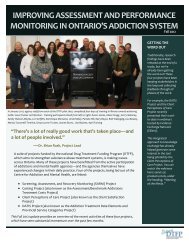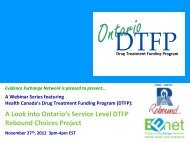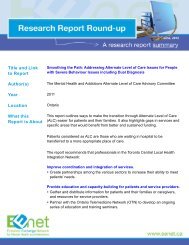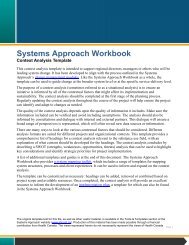Implementation of Early Psychosis Intervention Program ... - EENet
Implementation of Early Psychosis Intervention Program ... - EENet
Implementation of Early Psychosis Intervention Program ... - EENet
Create successful ePaper yourself
Turn your PDF publications into a flip-book with our unique Google optimized e-Paper software.
50o Team processes (e.g., regular team meetings to develop/discuss care plan, lower caseloads).o Regular contacts with clients for ongoing monitoring.2. Outreach and client engagementStandard 3 sets out the expectation that EPI programs use proactive outreach strategies such as inhome visits, outreach to families, and services provided as part <strong>of</strong> recreational opportunities inthe community, with the goal <strong>of</strong> keeping clients engaged in treatment, and reducing missedappointments and program drop-out.Summary <strong>of</strong> Results:o Lower frequency <strong>of</strong> implementation with only 63% <strong>of</strong> sites overall reporting using proactiveoutreach for client engagement ‘most <strong>of</strong> the time’.o Small programs and community agency sponsored programs were more likely than theircounterparts to indicate higher implementation (71% versus 57%, and 76% versus 53%respectively able to implement most <strong>of</strong> the time)o Across all sites, approximately half <strong>of</strong> all client face-to-face contacts occurred in <strong>of</strong>fices withthe remainder in community locations. Hospital sponsored sites reported somewhat higherrate <strong>of</strong> <strong>of</strong>fice contacts (60%) (Table 13).o Organizational policies may limit staff use <strong>of</strong> some outreach strategies such as transportingclients in staff vehicles, conducting home visits, and mobile devices/e-communications toconnect with clients.o Time was also noted as a limitation to outreach, especially in more rural areas where longerdistance travel is required.Chart 7: Outreach and client engagement: <strong>Implementation</strong>* relative to other elements (Q74)Public education<strong>Early</strong> referralWellness plansGraduat ionOutreach andFamily educationPhysical healthFamily supportWorking with IP unitsCrisis managementFamily role in assessmtClient psycho-educationAccess to psy assessmtResponse timesAntipsychotic meds useRelapse preventionstandard elements0 20 40 60 80 100% <strong>of</strong> sites reporting implementation 'most <strong>of</strong> the time'* % programs reporting implementation ‘most <strong>of</strong> the time’ versus ‘some <strong>of</strong> the time’ or ‘not too <strong>of</strong>ten’.
















